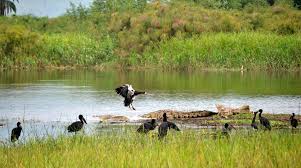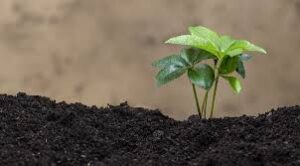- What is the ecosystem?
An ecosystem is a community of living organisms (plants, animals, and microorganisms) and non-living components (such as air, water, and mineral soil) that interact with each other in a specific environment. Ecosystems can be found in various forms, including:
1. Terrestrial ecosystems (forests, grasslands, deserts)
2. Freshwater ecosystems (rivers, lakes, wetlands)
3. Marine ecosystems (coral reefs, estuaries, open ocean)

Ecosystems are characterized by the interactions between biotic (living) and abiotic (non-living) factors, which shape the environment and support life. These interactions include:
– Energy flow: The transfer of energy from one organism to another through food chains and webs.
– Nutrient cycling: The exchange of nutrients between living organisms and the environment.
– Population dynamics: The study of the size, structure, and distribution of populations within an ecosystem.
Ecosystems provide essential services, including:
– Air and water purification
– Soil formation and nutrient cycling
– Climate regulation
– Habitat provision for diverse plant and animal species
– Recreation and tourism
Understanding ecosystems is crucial for managing natural resources, conserving biodiversity, and mitigating the impacts of human activities on the environment.
- What is the ecology?
Ecology is the scientific study of the relationships between living organisms (plants, animals, microorganisms) and their environment (biotic and abiotic factors). It examines how organisms interact with each other and their surroundings, including:
1. Interactions between organisms: Predation, competition, symbiosis, and mutualism.
2. Interactions with the environment: Adaptation to climate, soil, water, and other environmental factors.

Ecology aims to understand:
1. Ecosystem structure and function: How ecosystems work and respond to changes.
2. Population dynamics: Changes in population size, distribution, and abundance.
3. Biodiversity: Variety of species, genetic diversity, and ecosystem diversity.
Ecology informs:
1. Conservation: Preserving ecosystems, species, and natural resources.
2. Environmental management: Sustainable use of resources, pollution control.
3. Climate change mitigation: Understanding ecological impacts and developing strategies.
Ecology is an interdisciplinary field, drawing from biology, chemistry, physics, geology, and more.
- What is the different between ecosystem and ecology?
Ecosystem and ecology are related but distinct concepts:
Ecosystem
– An ecosystem is a community of living organisms (plants, animals, and microorganisms) interacting with each other and their physical environment (such as soil, water, air, and sunlight).
– Ecosystems can be small (like a pond) or large (like a forest or desert).
– It focuses on the structure and function of these interactions within a specific environment.
Ecology
– Ecology is the scientific study of ecosystems and the interactions between organisms and their environment.
– It examines the relationships between biotic (living) and abiotic (non-living) components, such as how organisms adapt to their environment, compete for resources, and influence each other.
– Ecology seeks to understand the patterns and processes that govern ecosystems and how they respond to changes, such as climate change, pollution, or habitat destruction.
– Ecosystem refers to the system itself (the community of organisms and their environment).
– Ecology is the study of these systems and their interactions.
Think of it like studying a forest:
– The forest, with its plants, animals, soil, and climate, is an ecosystem.
– The study of how all these components interact and function together is ecology.
- How many types of ecosystem?
Ecosystems can be broadly categorized into several types based on their environment and characteristics. Here are some of the main types of ecosystems:
1. Terrestrial Ecosystems (Land-based ecosystems)
– Forest Ecosystems: Tropical rainforests, temperate forests, boreal forests (taiga).
– Grassland Ecosystems: Prairies, savannas, steppes.
– Desert Ecosystems: Arid regions with low rainfall and sparse vegetation.
– Tundra Ecosystems: Cold, treeless regions found in Arctic and Antarctic areas.
2. Aquatic Ecosystems (Water-based ecosystems)
– Freshwater Ecosystems:
– Rivers and Streams: Flowing water ecosystems.
– Lakes and Ponds: Still water ecosystems.
– Wetlands: Marshes, swamps, and bogs.
– Marine Ecosystems:
– Coral Reefs: Biodiverse ecosystems found in shallow, tropical waters.
– Estuaries: Coastal areas where freshwater rivers meet the ocean.
– Open Ocean: The vast, deep waters of the ocean.
3. Artificial Ecosystems (Human-made ecosystems)
– Agricultural Ecosystems: Farms, orchards, and plantations.
– Urban Ecosystems: Cities and towns, including parks, gardens, and urban wildlife.
4. Specialized Ecosystems
– Mountain Ecosystems: Ecosystems found in mountainous regions, often with unique species adapted to high altitudes.
– Cave Ecosystems: Subterranean ecosystems with specialized organisms adapted to dark, stable environments.
– Polar Ecosystems: Ecosystems found in the Arctic and Antarctic regions, characterized by extreme cold and ice.
Each type of ecosystem has its own unique characteristics, species, and ecological processes. These ecosystems play a crucial role in maintaining biodiversity, regulating climate, and providing resources for humans and other organisms.
- Relationship between ecosystem and ecology?
Ecosystems and ecology are closely related concepts in environmental science. Here’s how they are connected:
Ecosystem:
– An ecosystem is a community of living organisms (plants, animals, and microorganisms) interacting with each other and their physical environment (such as soil, water, air, and sunlight).
– Ecosystems can be natural (like forests, oceans, or wetlands) or artificial (like agricultural fields or urban areas).
– Ecosystems are characterized by the flow of energy and nutrients through the system, as well as the interactions between biotic (living) and abiotic (non-living) components.
Ecology:
– Ecology is the scientific study of ecosystems and the interactions between organisms and their environment.
– Ecology examines how ecosystems function, how organisms adapt to their environment, and how human activities impact ecosystems.
– Ecologists study the relationships between living organisms and their surroundings to understand patterns and processes in nature.
Relationship:
– Ecosystem is the object of study, while ecology is the study itself.
– Ecosystems are the real-world systems where interactions between organisms and their environment occur.
– Ecology seeks to understand and explain how these ecosystems work, how they are structured, and how they respond to changes.
In essence, ecosystems are the natural systems that ecology studies. By understanding ecosystems through ecology, scientists can develop strategies to conserve biodiversity, manage natural resources, and mitigate environmental impacts.
- Example of ecosystem and ecology?
Here are examples to illustrate the difference between ecosystem and ecology:
Ecosystem Example:
– Coral Reef Ecosystem: A coral reef is a type of ecosystem found in shallow, tropical waters. It consists of:
– Biotic components: Coral polyps, fish, sea turtles, algae, and other marine organisms.
– Abiotic components: Water, sunlight, temperature, salinity, and minerals.
The coral reef ecosystem is a complex web of interactions between these living and non-living components, where each organism plays a role in the functioning of the system.
Ecology Example:
– Studying a Coral Reef Ecosystem: Ecology is the study of how the coral reef ecosystem functions. An ecologist might investigate:
– How coral polyps interact with algae and other organisms.
– How changes in water temperature affect coral bleaching.
– How fish populations are influenced by the availability of food and shelter in the reef.
In this example:
– The coral reef is the ecosystem (the system being studied).
– The study of the coral reef and its interactions is ecology (the scientific discipline that investigates the ecosystem).
Another Example:
– Forest Ecosystem: A forest ecosystem includes trees, animals, microorganisms, soil, water, and sunlight.
– Forest Ecology: Forest ecology studies the relationships between these components, such as how trees provide habitat for animals, how nutrients cycle through the ecosystem, and how human activities like logging impact the forest.
In both examples, the ecosystem is the natural system, and ecology is the study of that system.
Read more Topics ,
- Brahmaputra Nadi kha hai ?
- Brahmaputra nadi ki lambai kitni hai ?
- Jhelam nadi kha hai ?
- Kedarnath yatra 2025 ?
- Indus River ki lambai kitni hai ?